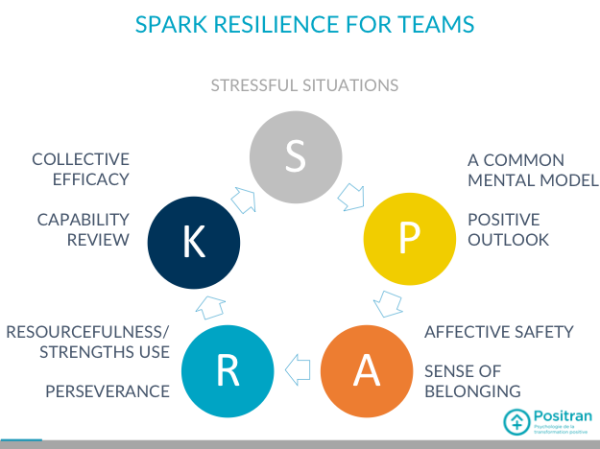Building team tesilience
By Pr. Ilona Boniwell.
Professor Ilona Boniwell is one of the European leaders in Positive Psychology, having founded and headed the first Masters Degree in Applied Positive Psychology (MAPP) in Europe at the University of East London. Nowadays, she heads the International MSc in Applied Positive Psychology (I-MAPP) at Anglia Ruskin University (that includes a dedicated positive psychology coaching pathway), teaches Positive Management at l’Ecole Centrale Paris and HEC, and consults around the world as a director of Positran. Her main teaching expertise lies in the areas of Positive Psychology and Positive Psychology applications, with research interests around: subjective time use, time perspective, eudaimonic well-being, tangible tools and applications of Positive Psychology to business, executive coaching and education.


Work is increasingly structured in and around teams—groups of individuals within an organisation who share a clearly defined membership and are responsible for achieving shared goals. Modern day working environments expose their teams to a variety of stressors such as tight deadlines, frequently changing team structures, carrying out more tasks with less resources, coupled with potential high consequences for the team members in terms of financial or psychological impact (Alliger, Cerasoli, Tannenbaum & Vessey, 2015).
Team resilience can be defined as a “dynamic, psychosocial process which protects a group of individuals from the potential negative effect of stressors they collectively encounter. It comprises of the processes whereby team members use their individual and collective resources positively to adapt when experiencing adversity” (Morgan, Fletcher & Sarkar, 2013, p. 45). Studies have found that resilient teams are more creative, productive and flexible during tough times (Sharma & Sharma, 2016). Simultaneously, team members display a higher level of wellbeing and higher readiness for future challenges (McEwen & Boyd, 2018).
When the adversity strikes, be it Covid, a rapid move towards remote working or forced restructuring (or all of the above), resilience of teams may be put to test. Psychology knows that Stressors, as a function of our individual and collective Perceptions, tend to trigger an emotion or Affect. This leads to a subsequent behavioural Reactions and a certain learning or Knowledge gained or not from the experience (this is called SPARK process). For example, a shared negative Perception (e.g., “Many of our team members only pretend to be working at a distance”) will send collective Affect into a downfall activating the feelings of betrayal, disappointment, hatred, often leading to legally based (Re)actions and culminating in the negative evaluation of the overall performance (Knowledge).
The opposite, upward spiral, is just as possible. So what are the characteristics of resilient teams that can activate this upward spiral? We have used the SPARK model to organise eight major characteristics highlighted by scientific literature (Sharma & Sharma, 2016; McEwen and Boyd, 2018; Gucciardi et al., 2018) into easy to understand categories and will share with you some of the tools a manager, coach or trainer can use to understand and develop resilience in teams.

1. A common mental model (perception). To be ready for the adversity, all team members must be on the same page about their roles, tasks, team composition and group norms. This is their mental model of teamwork, which helps them coordinate effectively, predict one another’s behaviour, and make decisions quickly and without hesitation. These mental models have to be both accurate (Are we doing the right thing at the right time?) and shared (Do we all agree on what we’re supposed to do?) in order to be effective.
How can we build a common mental model? One of my favourite tools is Team Canvas, a process that enables the team to clarify their roles, goals, values, proposes and common purpose (Ivanov & Voloshchuk, 2015).
2. Positive outlook (perception) is equally important. Being open-minded, optimistic, noticing progress and opportunities helps teams adapt, improvise and develop new ideas, being able to adjust to changing circumstances in real time. What actions can be taken to develop your team’s positive outlook? Practice re-framing challenges as opportunities and introduce creativity techniques such as design thinking, brainstorming, and Lego Serious Play (Bab & Boniwell, 2018).
3. Affective safety (affect). Team resilience is enhanced when members share the belief that it is safe to take interpersonal risks in their team, such as offering unusual or creative ideas without fear of being criticized or singled out by fellow team members. This enables a greater diversity of perspectives at a time when such diversity is needed. Affective safety can be developed, for example, by putting into place a ritual of positive introductions that enable the staff to present who they really are to others. Also, allowing and accepting difficult emotions can remind the team that vulnerability is allowed and is a part of work life.
4. Sense of belonging (affect). Resilient teams develop their own affective rituals, like Apero Zoom, playful use of emoticons stickers/magnets, mindful moments before starting a meeting, between tasks, or during interactions with colleagues. Implicit and explicit rituals are in place to help each other maintain emotional management through sleeping, exercising, taking time to rest. As a result, most resilient teams observe a strong sense of belonging, collaboration and positive relationships within the team (that also span beyond work).
5. Resourcefulness (reaction). An emerging demand for teams is the need to do more with less. Regardless of the industry, expectations of deliverables are often not balanced with resources – for example, the budget and staff provided. This demands that teams become better in harnessing team member strengths and optimising strength-task fit. It also requires regular discussion on what to prioritise and where to direct collective energy. In fast moving jobs where demands change frequently, reallocation of resources may be needed. To what extent does your team know what resources it has and are these deployed optimally for a common goal?
My favourite tool to develop a team’s awareness of each other’s strengths are Digital Strengths Cards Teamscope+ (Positran, 2020). Initially completed online by each team member, the debriefing can be held on-line or face-to-face allowing teams to optimise strength-task allocation as a consequence.
6. Perseverance (reaction). Whilst it is important to find the best way forward, it is equally important to keep going when things are tough and the way is full of obstacles. Having a solution focus and performing tasks that match individual strengths help perseverance and can even enable the team to reach team-flow.
7. Capability review (knowledge). Resilient teams have strong feedback rituals, seek feedback and improve their processes as a result. Does your team have built-in processes for continuous improvement or does it wait until change is imposed and then have difficulty adjusting to it? Encourage the use of daily reviews, or exchanging feedback in a positive way between peers on incomplete pieces of work. Challenge colleagues to approach ‘failures’ positively, by using practices such as “Failure CV” or “Fuck up nights”
8. Collective efficacy (knowledge). Resilient teams believe they can effectively complete tasks together. Beyond each individual having confidence in their ability to be successful, team members collectively believe that they can take effective action together. Collective efficacy is a consequence of successful achievement of goals, but can be further developed by challenging training (think team-level escape game), celebration of accomplishments at the end of each week and showing gratitude and appreciation to one another.
References
Alliger, G. M., Cerasoli, C. P., Tannenbaum, S. I., & Vessey, W. B. (2015). Team resilience: How teams flourish under pressure. Organizational Dynamics, 44(3), 176–184.
Bab, M., & Boniwell, I. (2016). Exploring positive psychology with LEGO® Serious Play®. Positran.
Gucciardi, D. F., Crane, M., Ntoumanis, N., Parker, S. K., Thøgersen-Ntoumani, C., Ducker, K. J., Peeling, P., Chapman, M. T., Quested, E., & Temby, P. (2018). The emergence of team resilience: A multilevel conceptual model of facilitating factors. Journal of Occupational and Organizational Psychology, 91(4), 729–768.
Ivanov, A. & Voloshchuk, M. (2015). Team Canvas. http://theteamcanvas.com
McEwen, K., & Boyd, C. M. (2018). A measure of team resilience. Journal of Occupational and Environmental Medicine, 60(3), 258–272.
Morgan, P. B. C., Fletcher, D., & Sarkar, M. (2013). Defining and characterizing team resilience in elite sport. Psychology of Sport and Exercise, 14(4), 549–559.
Positran (2020). Digital Strengths Cards Teamscope +
Sharma, S., & Sharma, S. K. (2016). Team resilience: scale development and validation. Vision, 20(1), 37-53.





